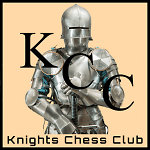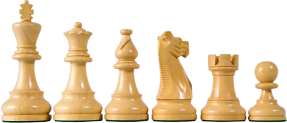
Knights Chess Club
Welcome To All, Young And Old


Studies: Chess Benefits for Students
In a 1973-74 Zaire study conducted by Dr. Albert Frank, employing 92 students, age 16-18, the chess-playing experimental group showed a significant advancement in spatial, numerical and administrative-directional abilities, along with verbal aptitudes, compared to the control group. The improvements held true regardless of the final chess skill level attained. [1], [2], [7]
In a 1974-1976 Belgium study, a chess-playing experimental group of fifth graders experienced a statistically significant gain in cognitive development over a control group, using Piaget’s tests for cognitive development. Perhaps more noteworthy, they also did significantly better in their regular school testing, as well as in standardized testing administered by an outside agency which did not know the identity of the two groups. Quoting Dr. Adriaan de Groot: “In addition, the Belgium study appears to demonstrate that the treatment of the elementary, clear-cut and playful subject matter can have a positive effect on motivation and school achievement generally...” [1], [3], [7]
In a 1977-1979 study at the Chinese University in Hong Kong by Dr. Yee Wang Fung, chess players showed a 15% improvement in math and science test scores. [4]
A four-year study (1979-1983) in Pennsylvania found that the chess-playing experimental group consistently outperformed the control groups engaged in other thinking development programs, using measurements from the Watson-Glaser Critical Thinking Appraisal and the Torrance Tests of Creative Thinking. [1], [4], [5], [6], [7], [23]
The 1979-1983 Venezuela “Learning to Think Project,” which trained 100,000 teachers to teach thinking skills and involved a sample of 4,266 second grade students, reached a general conclusion that chess, methodologically taught, is an incentive system sufficient to accelerate the increase of IQ in elementary age children of both sexes at all socio-economic levels. [1], [7], [8], [9], [10]
During his governor’s teacher grant from the New Jersey State Department of Education, William Levy found that chess consistently (1980-1987) promoted self-esteem after a year of exposure. Many students’ self-images improved dramatically. [7], [11]
According to a two-year study conducted in Kishinev under the supervision of N.F. Talisina, grades for young students taking part in the chess experiment increased in all subjects. Teachers noted improvement in memory, better organizational skills, and for many increased fantasy and imagination (Education Ministry of the Moldavian Republic, 1985). [1], [7]
In his 1986 pilot study, Dr. Ferguson found that it is possible to enhance achievement by focusing on individuals’ modality strengths, creating an individualized thinking plan, analyzing and reflecting upon one’s own problem solving processes, sharing his/her thinking system with peers, and modifying the system to integrate other modalities. [1], [7], [12]
During the 1987-88 “Development of Reasoning and Memory through Chess,” all students in a rural Pennsylvania sixth grade self-contained classroom were required to participate in chess lessons and play games. None of the pupils had previously played chess. The pupils significantly improved in both memory and verbal reasoning. The effect of the magnitude of the results is strong (eta2 is .715 for the Memory test gain compared to the Norm). These results suggest that transfer of the skills fostered through the chess curriculum did occur. [1], [7], [13]
A 1989-92 New Brunswick, Canada study, using 437 fifth graders split into three groups, experimenting with the addition of chess to the math curriculum, found increased gains in math problem-solving and comprehension proportionate to the amount of chess in the curriculum. [14]
A 1990-92 study using a sub-set of the New York City Schools Chess Program produced statistically significant results concluding that chess participation enhances reading performance. [15], [16], [23]
“Playing Chess: A Study of Problem-Solving Skills in Students with Average and Above Average Intelligence,” a study by Philip Rifner, was conducted during the 1991-1992 school term. The study sought to determine whether middle school students who learned general problem solving skills in one domain could apply them in a different domain. Data indicated that inter-domain transfer can be achieved if teaching for transfer is an instructional goal. [17]
During the 1995-1996 school year, two classrooms were selected in each of five schools. Students (N = 112) were given instruction in chess and reasoning in one classroom in each school. Pupils in the chess program obtained significantly higher reading scores at the end of the year. It should be noted that while students in the chess group took chess lessons, the control group (N = 127) had additional classroom instruction in basic education. The control group teacher was free to use the “chess period” any way he/she wanted, but the period was usually used for reading, math or social studies instruction. The control groups thus had more reading instruction than the chess groups. Even so, the chess groups did better on the reading post-test; therefore, the gains in the chess groups were particularly impressive. [18]
In a 1994-97 Texas study, regular (non-honors) elementary students who participated in a school chess club showed twice the improvement of non-chess players in Reading and Mathematics between third and fifth grades on the Texas Assessment of Academic Skills. [19], [20]
Researchers and educators have questioned what causes this growth. The Venezuelan study claimed: “Chess develops a new form of thinking, and this exercise is what contributes to increase the intelligence quotient.” [10] More recent researchers speculate that it is the growth of new synaptic connections. Chess promotes the growth of dendrites!
Why does chess have this impact?
Briefly, there appear to be at least seven significant factors:
- Chess accommodates all modality strengths.
- Chess provides a far greater quantity of problems for practice.
- Chess offers immediate punishments and rewards for problem solving.
- Chess creates a pattern or thinking system that, when used faithfully, breeds success. The chess playing students had become accustomed to looking for more and different alternatives, which resulted in higher scores in fluency and originality.
- Competition. Competition fosters interest, promotes mental alertness, challenges all students, and elicits the highest levels of achievement (Stephan, 1988).
- A learning environment organized around games has a positive affect on students’ attitudes toward learning. This affective dimension acts as a facilitator of cognitive achievement (Allen & Main, 1976). [21] Instructional gaming is one of the most motivational tools in the good teacher’s repertoire. Children love games. Chess motivates them to become willing problem solvers and spend hours quietly immersed in logical thinking. These same young people often cannot sit still for fifteen minutes in the traditional classroom.
- Chess supplies a variety and quality of problems. As Langen (1992) states: “The problems that arise in the 70-90 positions of the average chess game are, moreover, new. Contexts are familiar, themes repeat, but game positions never do. This makes chess good grist for the problem-solving mill.”
NOTES
- Robert Ferguson, “Chess in Education Research Summary,” paper presented at the Chess in Education A Wise Move Conference at the Borough of Manhattan Community College, January 12-13,1995.
- Albert Frank, “Chess and Aptitudes,” doctoral dissertation, 1974, Trans. Stanley Epstein.
- Johan Christiaen, “Chess and Cognitive Development,” doctoral dissertation, 1976, Trans. Stanley Epstein.
- Donna Nurse, “Chess & Math Add Up,” Teach, May/June 1995, p. 15, cites Yee Wang Fung’s
- Robert Ferguson, “Teaching the Fourth ‘R’ (Reasoning) through Chess,” School Mates, 1(1), 1983, p. 3.
- Robert Ferguson, “Developing Critical and Creative Thinking through Chess,” report on ESEA Title IV-C project presented at the annual conference of the Pennsylvania Association for Gifted Education, Pittsburgh, Pennsylvania, April 11-12, 1986.
- Robert Ferguson, “Teaching the Fourth ‘R’ (Reflective Reasoning) through Chess,” doctoral dissertation, 1994.
- Isaac linder, “Chess, a Subject Taught at School,” Sputnik: Digest of the Soviet Press, June 1990, pp. 164-166.
- Rafael Tudela, “Learning to Think Project,” Commission for Chess in Schools, 1984, Annex pp. 1-2.
- Rafael Tudela, “Intelligence and Chess,” 1984.
- William Levy, “Utilizing Chess to Promote Self-Esteem in Perceptually Impaired Students,” a governor’s teacher grant program through the New Jersey State Department of Education, 1987.
- Robert Ferguson, “Tri-State Area School Pilot Project Findings,” 1986.
- Robert Ferguson, “Development of Reasoning and Memory through Chess,” 1988.
- Louise Gaudreau, “Étude Comparative sur les Apprentissages en Mathématiques 5e Année,” a study comparing the Challenging Mathematics curriculum to traditional math, 1992. (The authors are Michel and Robert Lyons. The ISBN is 2-89114-472-4. This collection has been sold to La Chenelière & McGraw Hill in Montreal. You can reach them at (514) 273-7422. Ask for Michel Solis.)
- Stuart Margulies, “The Effect of Chess on Reading Scores: District Nine Chess Program Second Year Report,” 1992.
- Chess-in-the-Schools, Web page at http://www.symbolic.com/chess/chsgym.htm.
- Philip Rifner, “Playing Chess: A Study of Problem-Solving Skills in Students with Average and Above Average Intelligence,” doctoral dissertation, 1992.
- Stuart Margulies, “The Effect of Chess on Reading Scores,” 1996.
- James liptrap, “Chess and Standard Test Scores,” Chess life, March 1998, pp. 41-43.
- James liptrap, “Chess and Standardized Test Scores,” Chess Coach Newsletter, Spring 1999, Volume 11 (1), pp. 5 & 7.
- L.E. Allen & D.B. Main, “Effect of Instructional Gaming on Absenteeism: the First Step,” The Journal for Research in Mathematics Education, 1976, 7 (2), p. 114.
- Naciso Rabell Mendez, “Report by the World Chess Federation (FIDE) to the United Nations Organization (UNO),” June 1988, quotes Dr. Klaus’ comments.
- Kathleen Vail, “Check This, Mate: Chess Moves Kids,” The American School Board Journal, September 1995, pp. 38-40.
Material excerpted or adapted from the Illowa Chess Club: TEACHER'S GUIDE: RESEARCH AND BENEFITS OF CHESS by Dr. Robert C. Ferguson






